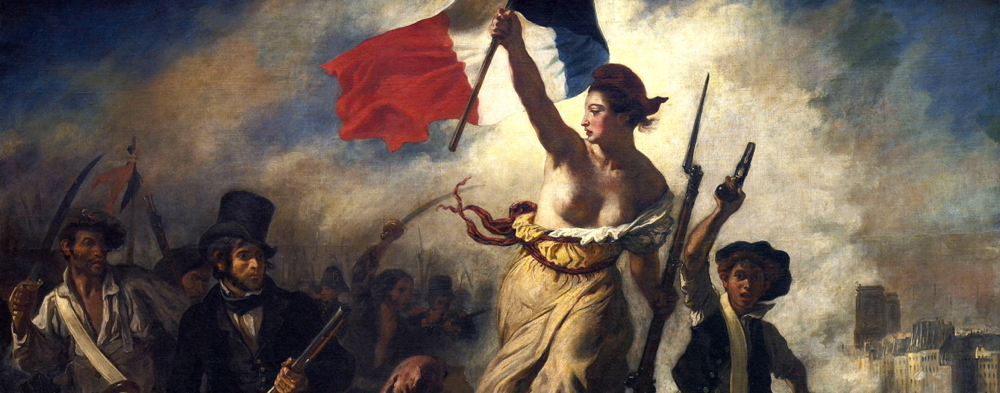
"DONALD TRUMP: FRIEND, FOE, OR SCHMO?"
A Talk given to the U3A, Newport Branch (5 February, 2025)
[Created: 10 February, 2025]
[Updated: 10 February, 2025] |
Note
This is a summary of my talk with the images and graphs I used along with an abbreviated version of my comments and observations.
Also available is a PDF of the overhead slides.
Contents of the talk:
- Introduction
- Friend, Foe, or Schmo?
- What issues got Trump elected?
- Is DT a "right-wing populist"?
- Problems with the Traditional Political Spectrum
- What is a "populist"?
- Who voted for DT and how?
- DT's Policies to "Make America Great Again"
- Some economic theory to consider
- Industrial Policy
- Tariff Policy
- Conclusion: Foe and Schmo
(Spoiler alert) My conclusion is that :
- DT is a "foe" of economic freedom and prosperity for the ordinary consumer and worker
- DT is a "schmo" for his authoritarian bombastic behaviour and his ignorance of basic economics
About the Speaker
David Hart is a retired historian who has studied at :
- Macquarie University BA (Hons) - he started his studies there in 1975 - 50 years ago this year
- The University of Mainz (then in West Germany)
- Stanford University (MA)
- King's College, Cambridge (PhD)
He is currently an Adjunct Research Fellow with the University of Western Australia Business School.
His area of interest is primarily the history of classical liberalism and the history of economic thought (especially 19th century French economic thought). He has spent the last 2 years building on his personal website a library of over 200 classic books of political and economic theory - most of them economics - in four different languages (English, French, German, and Italian).
He taught in the History Department at the University of Adelaide for 15 years (1986-2001) before moving to the U.S. to Direct the Online Library of Liberty run by the non-profit educational foundation, the Liberty Fund, which is based in Indianapolis, Indiana. The Online Library of Liberty won awards from the Library of Congress and the National Endowment for the Humanities.
David and Fran have lived in the U.S for 22 years (on and off) - 2 years in California and 20 years in Indiana. They experienced life under President Trump for 3 years - between 2017 and the beginning of 2020 when they returned to live in the Northern Beaches area of Sydney.
David spends his free time trimming some very large Murraya hedges.
Donald Trump: Friend, Foe, or Schmo?
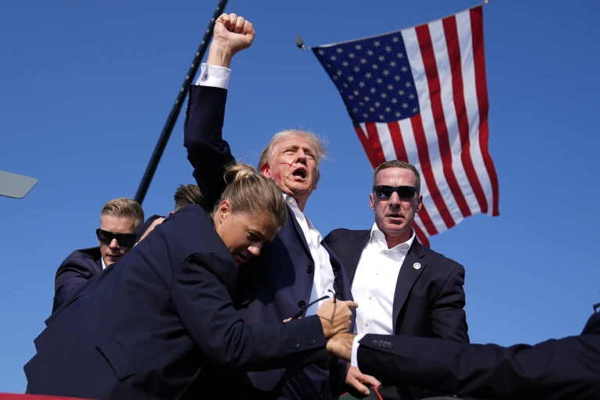
Image: Trump pumping fist at assassination attempt at Butler, Pennsylvania (13 July, 2024)
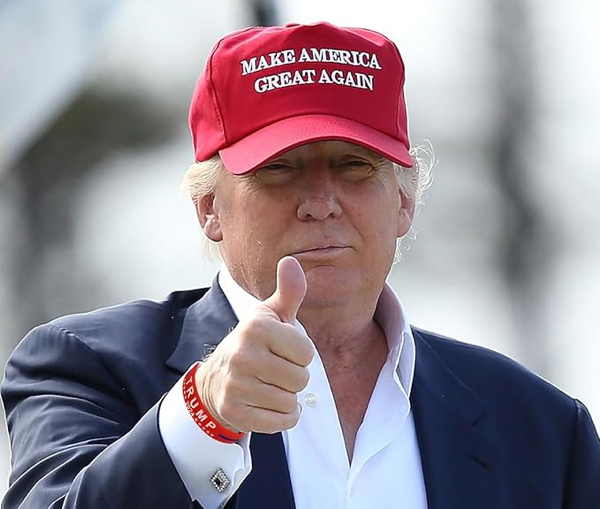
Image: Trump with MAGA baseball cap
1. INTRODUCTION
Friend, Foe, or Schmo?
Friend or Foe of what / of whom?:
- Freedom - of the American people, of other people (Australians)
- Prosperity - of the American people, of other people (Australians)
- Peaceful relations with other countries (Australia)
Schmo - שמאָק (shmok / schmuk)
Yiddish vulgar slang for “prick, jackass, fool” Australian trans. “dick-head”
What issues got Trump elected?
- the desire to “make America great again” in the eyes of both the American people and the rest of the world
- to reverse the decline in American manufacturing and jobs
- to impose high tariffs on military and economic rivals in order to do this
- to stop illegal immigration and deport the illegals
- to “drain the swamp” (to reduce the power of unelected bureaucrats and other officials in Washington)
- to end the politicization of the FBI and the DOJ
2.) IS DT A "RIGHT-WING POPULIST"?
Some Things to Consider
- Is Trump a “conservative”, a “populist”, a “fascist”, a “disruptor” of the established order?
- Where does he sit on the standard political spectrum?
- I think we need to do better than just “left” vs. “right” in order to understand the Trump phenomenon

Image: The traditional Left-Right Political Spectrum
- where is Trump?
- where am I (a libertarian)?
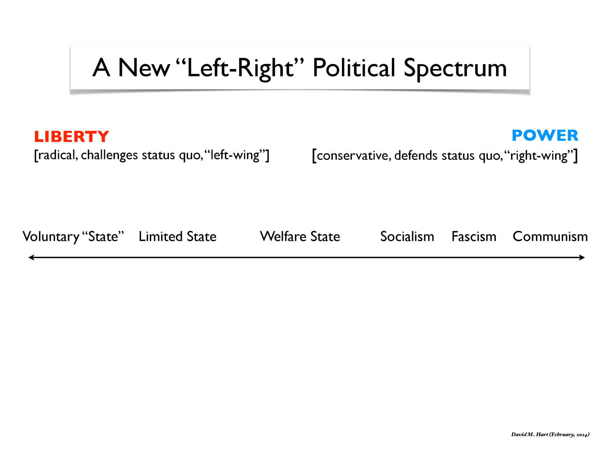
Image: A New "Left-Right" Political spectrum
- end points are two totally different ways of organizing a society
- "Liberty" - maximum amount of individual liberty in social, economic, political/legal realms, to exercise one's rights to life, liberty, and property as one sees fit (limited only by the of others to do the same - "law of equal liberty"
- Political Power - the state uses its power of coercion to control, regulate, own, tax, ban all aspects of individual behavior and economic activities
- this puts Libertarians at the far "Left" of the spectrum; and Stalinist/Maoist Communism at the far "Right"
- most mainstream parties in the West are thus "centrist" since they all support extensive regulation of the economy, some industrial policy, and a large public sector (health, education, welfare)
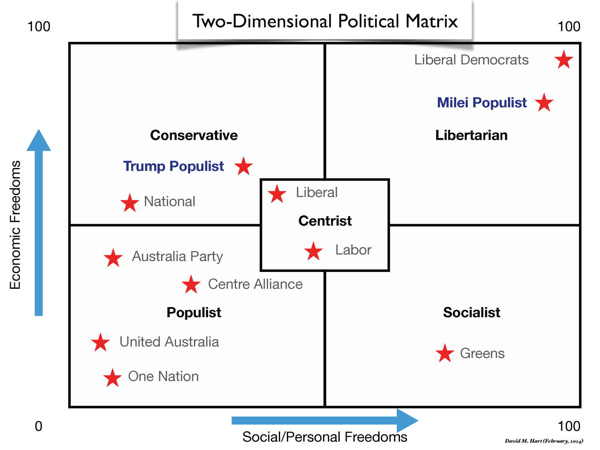
Image: Modified David Nolan Political Chart (David Boaz, CATO)
- quadrants with libertarian, conservative, socialist, and populist
- "populists" are typically thought of as people who want
- a "strong leader" to solve problems which the current ruling elites/parties ignore but which the ordinary people consider to be important
- the leader to use the power of the state to enact policies (government intervention in the economy) which benefit the "people" and not "the elite" (who are often depicted as corrupt or out of touch)
- this reveals the problem of too broad a definition of "populism" as Xavier Milei (Argentina) is a "libertarian / free market" populist, while DT is an "interventionist, illiberal" populist
3.) WHO VOTED FOR DT AND HOW?
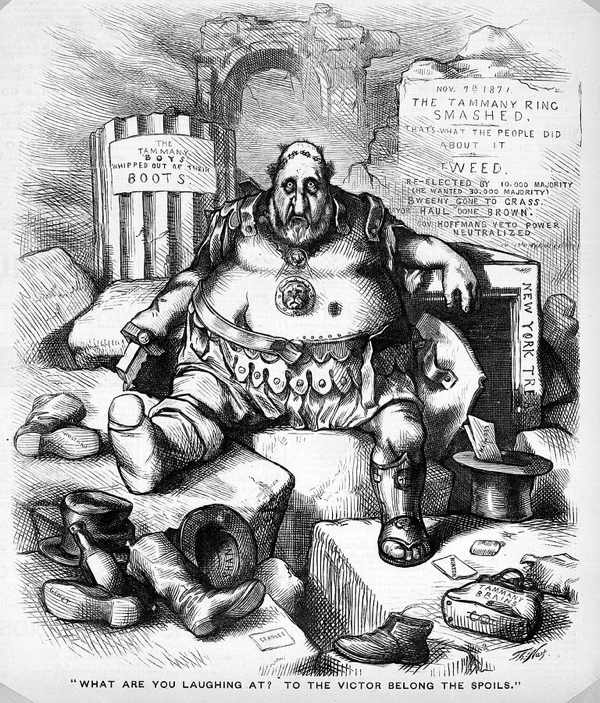
Image: Thomas Nast, “What are you laughing at? To the victor belong the spoils,” (Harper’s Weekly, 25 November 1871)
- Tammany Hall was the name given to the society founded in 1786 which ran the Democratic Party in NYC and NY state in the late 19thC
- it organised patronage for Irish immigrants
- the cartoonist Thomas Nash was an outspoken critic of William "Boss" Tweed who controlled NYC politics in the 1850s and 1860s
- "The Tammany Boys whipped out of their boots"
- he was arrested and jailed in 1872 and died in prison
Introduction
- many Australians and Europeans are asking themselves in bewilderment, "how could America vote for a person like Trump?"
- it is not true that "America" voted for DT
- some Americans in some places (more than others) for a variety of reasons voted for Trump
- some Americans in some places (more than others) for a variety of reasons voted for Kamala Harris
- some Americans voted for neither
Voting in America
- in order to vote you have to be "registered" at the state level; there are only three "parties" - the Republican party, the Democratic Party, and "Independent"; this entitles you to vote in the Primaries where candidates are chosen, and the actual elections
- there is no nationwide "Electoral Commission" as there is in Australia; elections are administered at the state level and there is broad scope for variation in how elections are administered; there are opportunities for corruption, but it is up to state legislatures to police (or not) police this; "voter ID" is a big issue, as there have been examples win the past of people voting more than once or dead people voting (especially in some of the notoriously corrupt Democrat controlled cities like Chicago; this opens up the possibility for people to claim that an election was "stolen" as DT did in 2020)
- voting is not compulsory is the US which means that "voter turnout" is an important issue in deciding an election
- people of voting age include foreign nationals who are not allowed to vote even thought they pay taxes
- of those who are eligible to vote, it is not compulsory to register to vote
- not all those who are registered to vote actually turn up to vote on election day
- voting is done by machines which do not leave a paper trail which can be audited in case of dispute
- one source of electoral corruption is for a city controlled by one party not to provide enough voting machines in electorates which vote strongly for the other party, thus forcing people to queue up to vote for long periods and then give up and go home without voting
- why are there only 2 candidates?
- there is an inbuilt set of restrictions which make the US system a virtual "Two-Party State"
- it is very hard for 3rd party candidates to get on the ballot (they have to amass a huge number of signatures for each election); and the privately run "Presidential Debates" committee which organizes the TV debates deliberately excludes any 3rd party candidates so 3rd parties find it difficult/impossible to be heard by millions of voters
- the two major parties do not have spend time and money getting their candidates on the ballot
- hence the importance now of social media and the internet, which DT made very good use of, given the opposition to him within his own party
Counting the Vote
There are various ways of counting "who voted" on election day
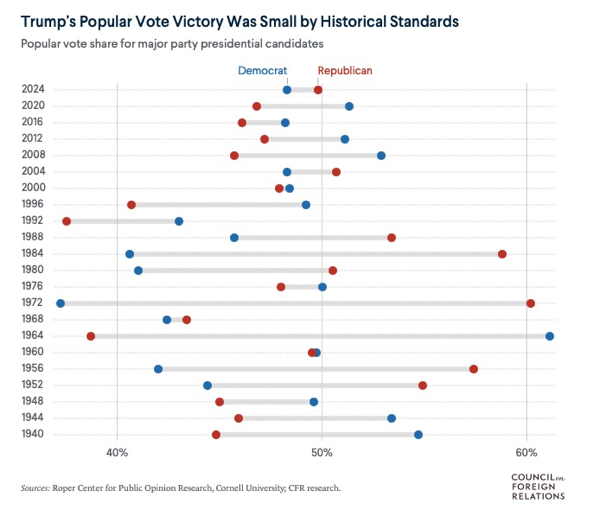
Image: Margin of Victory (Council of Foreign Relations)
Key to graph: 2024 - Donald Trump 2020 - Joe Biden 2916 - Donald Trump 2012 - Barak Obama 2008 - Barak Obama 2004 - George W. Bush 2000 - George W. Bush
1984 - Ronald Reagan 1980 - Ronald reagan 1972 - Richard Nixon
- there is the % of those who voted on the day for each of the candidates, known as the "turnout" and the "popular vote"
- James M. Lindsay, "The 2024 Election by the Numbers" The Council of Foreign relations (December 18, 2024) https://www.cfr.org/article/2024-election-numbers
- Trump won 77,284,118 votes, or 49.8 percent of the votes cast for president
- Kamala Harris won 74,999,166 votes or 48.3 percent of the votes cast.
- DT's margin of victory over Harris was 1.5 percentage points which was quite narrow by historical standards, so it was not really a landslide

Image: % of Voting-Eligible Population (VEP)
- a better / fairer method of calculation is % of VEP (voting eligible population ), those who were eligible to vote, but many of whom did not vote for various reasons
- Wikipedia table from "Voter turnout in United States presidential elections" https://en.wikipedia.org/wiki/Voter_turnout_in_United_States_presidential_elections
- in 2024 VEP = 156,302,318; turnout as % VEP = 63.9% of which the winner DT got 31.59%; KH got 30.66% (bottom line of table)
- significance of this number is that less than a third voted for DT, that more than 2.3 did not vote for DT; that 36.1% did not not vote for either candidate (which is a plurality of the votes)
- this raises question of why these people did not vote: lazy, stupid, ignorant, or disillusionment with the political system and the chances of their vote changing things
Trends / Patterns in American Voting
There are other important factors to consider in understanding who voted for DT
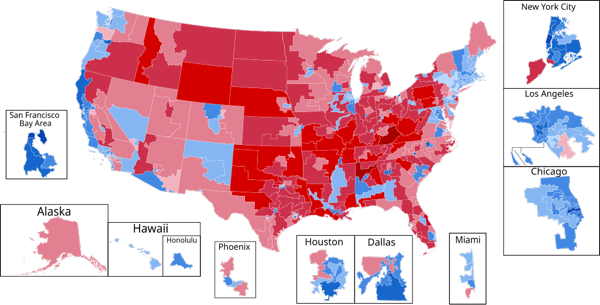
Image: Results by congressional district, shaded by winner (Wikipedia)
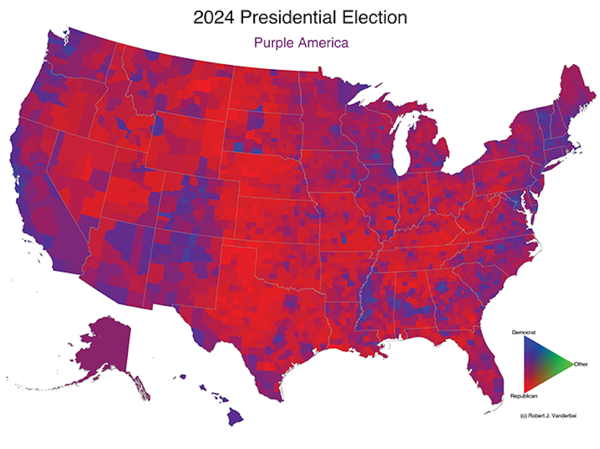
Image: "Purple America" - Results by County, shaded by winner (Vanderbei)
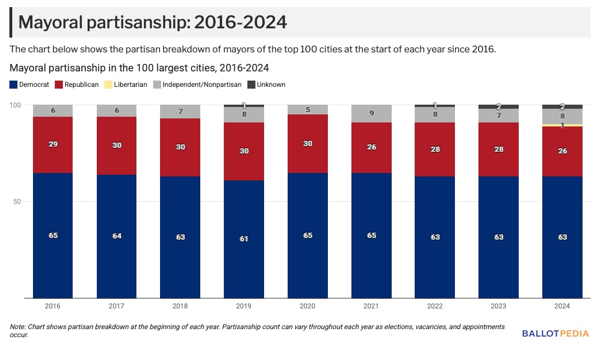
Image:
- geographic differences :
- voted strongly Democrat: West coast; Chicago and Great lakes states; North East
- rural vs urban counties: rural counties voted strongly Rep. was did ex-urbs (outer suburbs of large cities); while inner suburbs voted strongly Dems. ; need to remember most of the larger cities have been controlled by Dems for decades; e.g. LA (and California) used to be Repub. (Ronald Reagan was governor and then President) now the opposite
- "Purple America" Robert J. Vanderbei, "America’s counties are less purple than they used to be" The Conversation (December 5, 2024) https://theconversation.com/americas-counties-are-less-purple-than-they-used-to-be-243543
- ethnic differences:
- African and Hispanic American used to vote very strongly Dems until DT changed this; a major reason for his victory in 2024
- government workers (bureaucrats, teachers, postal workers, military personnel) strongly vote Dems (especially in D.C.) - D.C. voted 90.3% Dem.
4.) DT'S POLICIES TO "MAKE AMERICA GREAT AGAIN"
- What makes for "personal greatness" or "national greatness"?
- Its this something we should seek? if so, why?
- Some economic theory to consider
- Industrial Policy
- Tariff Policy
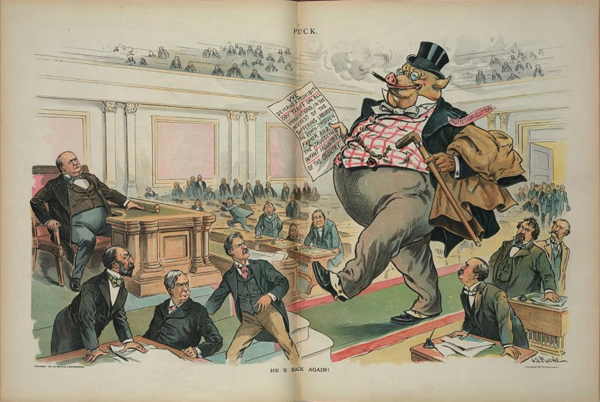
Image of the "Protection Glutton" pig in Congress (1897)
- J.S. Pughe, "He's back again" (1897)
- Illus. from Puck, v. 40, no. 1036, (1897 January 13)
- The print shows a gigantic, well-dressed pig labeled "Protection Glutton" confidently striding into Congress carrying a paper that states "We Demand a Prohibitory Tariff on all Imports, in the Interest of the Suffering Laborer, the Down-Trodden Farmer, and the Struggling Infant Industries of the Country".
Some Economic Theory to consider
Theories of Free & Open Trade vs. Privileged & Restricted Trade
Free & Open Trade
- Adam Smith, The Wealth of Nations (1776)
- J.B. Say, Traité d’Économie Politique (1803)
- Frédéric Bastiat, Sophismes Économique (1846)
Privileged & Restricted Trade
- Alex. Hamilton, Report on the Subject of Manufactures (1791)
- J.G. Fichte, Der geschlossene Handelsstaat (1800)
- Friedrich List, Das nationale System der Politischen Oekonomie (1841)
Different Economic Policies result from these different theories
Free & Open Trade
- private & unsubsidized production & consumption
- free & open competition between producers (domestic & foreign)
- market driven
- consumer-centric
- “liberal” globalisation
Privileged & Restricted Trade
- some producers granted govt. privileges (tariffs)
- restricted competition; foreign producers restricted or banned
- government directed
- producer-centric
- “managed” globalisation
Quote: Bastiat’s warning about “the Unseen”
| Dans la sphère économique, un acte, une habitude, une institution, une loi, n'engendrent pas seulement un effet, mais une série d'effets. De ces effets, le premier seul est immédiat; il se manifeste simultanément avec sa cause, on le voit. Les autres ne se déroulent que successivement, on ne les voit pas, heureux si on les prévoit! | In the world of economics, an action, a habit, an institution, a law does not give rise to only one effect but a series of effects. Of these effects only the first one is immediate. It shows itself simultaneously with its cause - it is seen. The others unfold only one after the other - they are not seen. One is lucky if one can foresee them! |
| Entre un mauvais et un bon Économiste, voici toute la différence: l'un s'en lient à l'effet visible; l'autre tient compte et de l'effet qu'on voit et de ceux qu'il faut prévoir. | This is the difference between a bad economist and a good economist: the former fixes their attention only on the visible effect; the latter takes into account both the effect which is seen and those effects which one has to foresee. |
Manufacturing and Industrial Policy
Compare with historical changes in Agricultural Employment
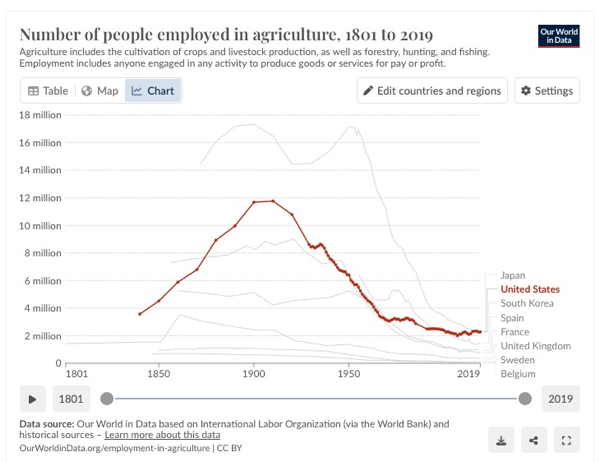
Image: US Total Number (not %) employed in Agriculture 1801-2019
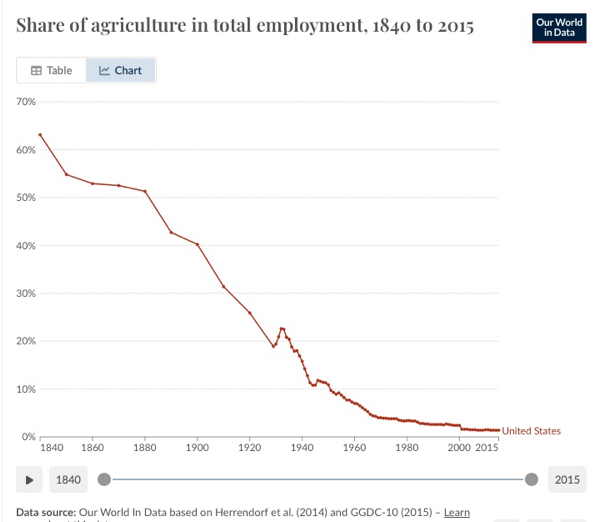
Image: US Agriculture Jobs as % Total Workforce 1840-2015
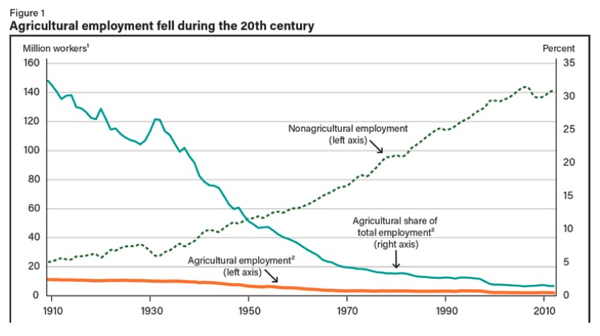
Image: Share ag. employment 1910-2017
- changes in manufacturing (jobs, output) are similar to what happened to agriculture - fewer jobs but much greater output and higher income
- "Changes in US Farm Labor: 1948-2017" Rural Migration Blog - UC Davis (March 29, 2022) https://migration.ucdavis.edu/rmn/blog/post/?id=2709
Manufacturing changes in Employment
Summary
- manufacturing jobs as % of total employment peaked in 1943 (39%) and has declined steadily - before rise of China and the liberalisation/globalisation of world trade
- output reached a peak on 2018 - US second largest manufacturing country
- sectoral change within manufacturing
- away from less valuable jobs in steel, furniture, clothing, and footwear and
- towards higher value aerospace products, computers, communications equipment, advanced processing chips, and chemicals
- also shift to services: 1 job lost in manufacturing = 8 new jobs in the private services sector
- greatest cause of loss of jobs is not imports (310,000 p.a.) but changes in domestic economy (24 m.)
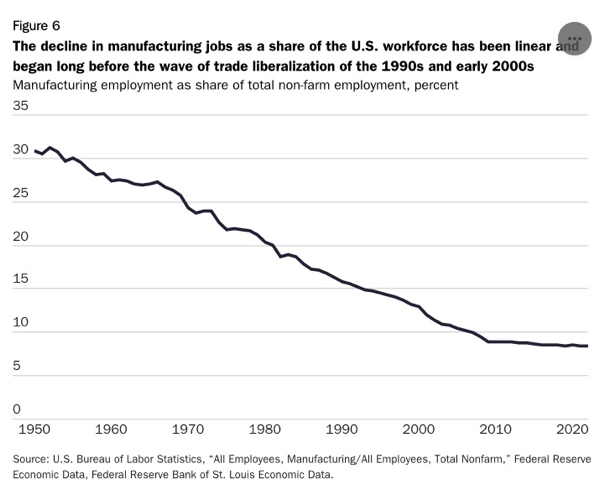
Image: US Manufacturing Jobs % Total Workforce 1950-2020
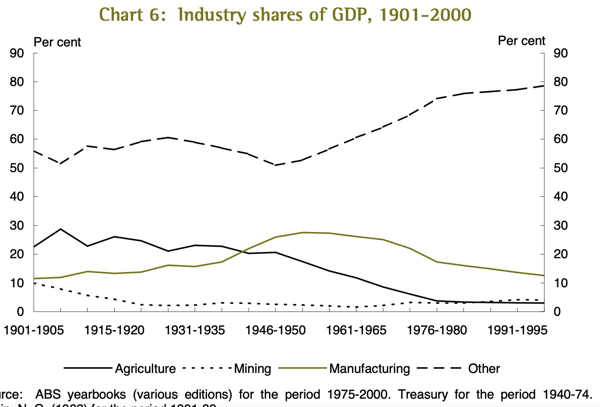
Image: compare with Australia: Industry shares of GDP 1901-2000
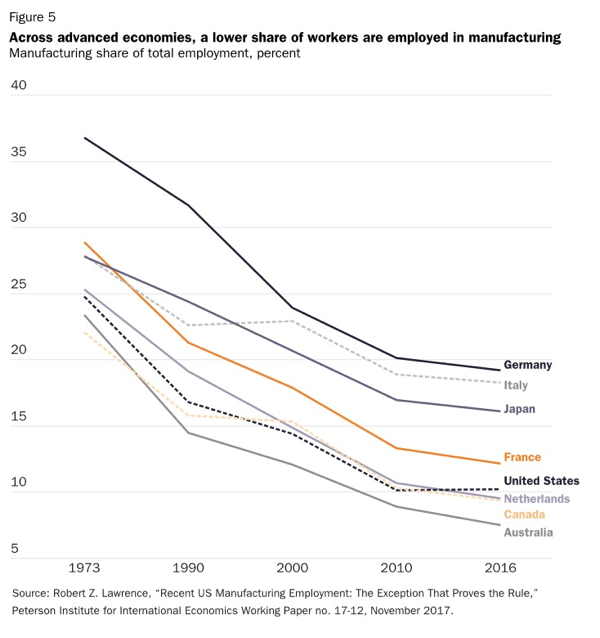
Image: Manufacturing Output % GDP 1970-2020 — 8 countries including Australia
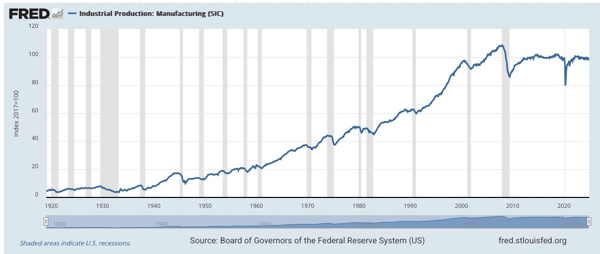
Image: US Value of Manufacturing Output 1920-2023
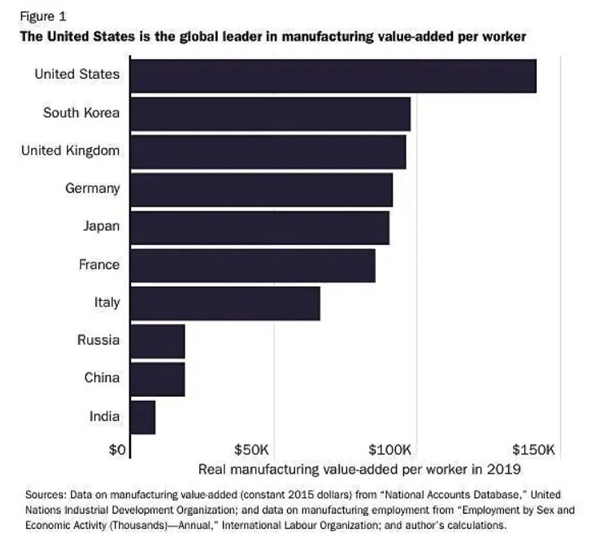
Image: Ranking of Manufacturing by added Value per worker

Image: Inverse relationsahip between productivity and employment
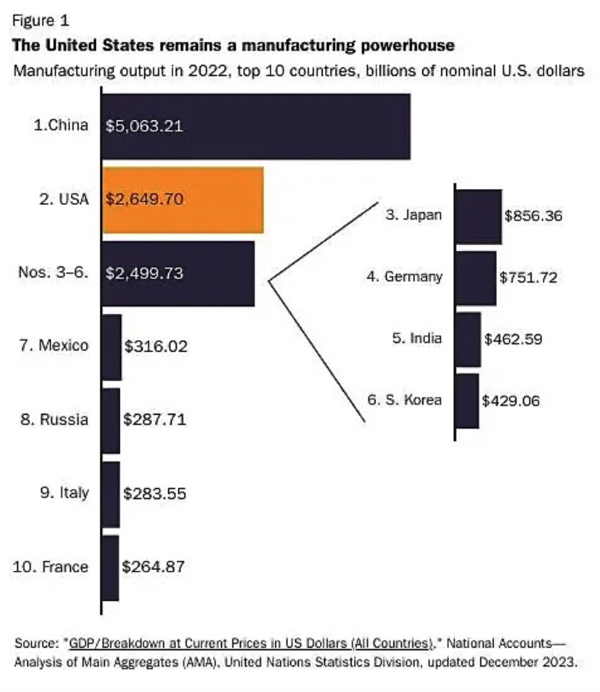
Image: Total Manufacturing Output
Let me conclude this section with a cartoon which reminds us of bastiat's keen insight about "the seen" and "the unseen":
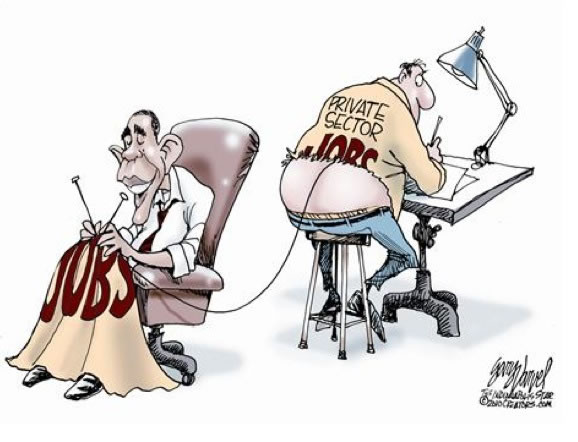
Image: Pres. Barak Obama creating new jobs (seen) at the expense of taxpayers (unseen)
Has there been a "hollowing out" of US Manufacturing? Is the Middle Class in decline?
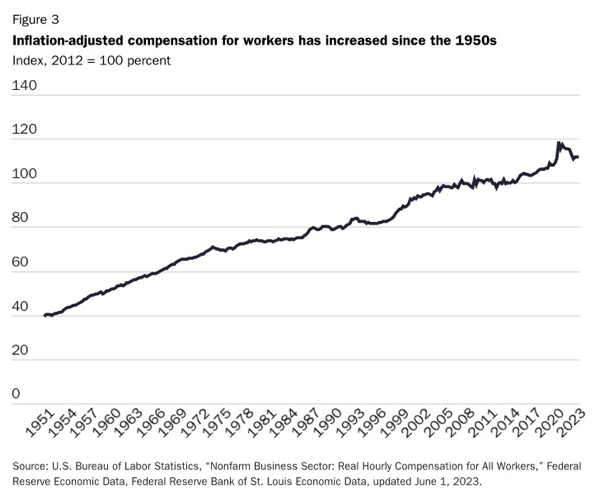
Image: US Non-Farm Jobs Compensation (inflation adjusted) 1951-2023
- compensation / wages of workers rose 50% 1967-2017
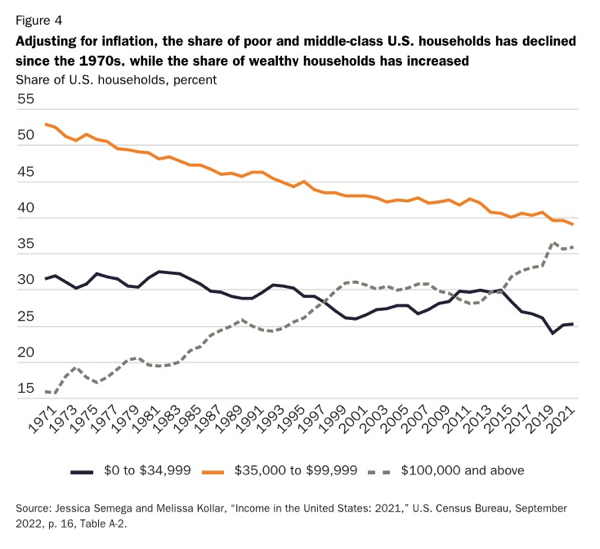
Image: US Income share of Low and Middle Classes
- falling % of poor and middle class households
- moving into wealthy household categories
This is part of a long historical process of "Enrichment"
Summary:
- we are currently going through another stage in the "Great Enrichment" of humankind (Deidre McCloskey)
- this began in earnest in the late 18thC in Netherlands, Britain, and other part of NW Europe and is continuing today with China and India
- at various stages in human development the bulk of the people engaged in the following for survival
- hunting and gathering - 100s thousands of years
- agriculture - perhaps 10,000 years
- then industrial activity in the late 18th and early 19thC (coal and petro-chemicals)
- our current stage is the emergence of "services" (knowledge based activities)
- some historians attribute this to the combination of factors
- the idea that productive activity and exchange with others was a worth while, even an honorable activity (breaking away from the aristocratic idea that
- the emergence of societies / legal system which protected the ordinary operations rights to life, liberty, and property (contracts enforced)
- the corresponding abolition of coerced labor such as slavery and serfdom
- the weakening of the power of non-productive, parasitical groups who lived off coerced labour, political privilege (tariffs, monopolies, subsidies), and taxation
- the mergence of entrepreneurs and innovators who could make money by serving the needs / wants of ordinary consumers (mass market)
- the expansion of free markets and free trade domestically and internationally (globalisation)
- there have been significant "hiccups" in this process, especially during the 20thC
- WW1 and WW2
- the Great Depression
- the rise of Communist regimes in Russia, and China, and elsewhere
- we seem to be going through a period now of many counties questioning or abandoning the above "factors" which made this "enrichment" possible
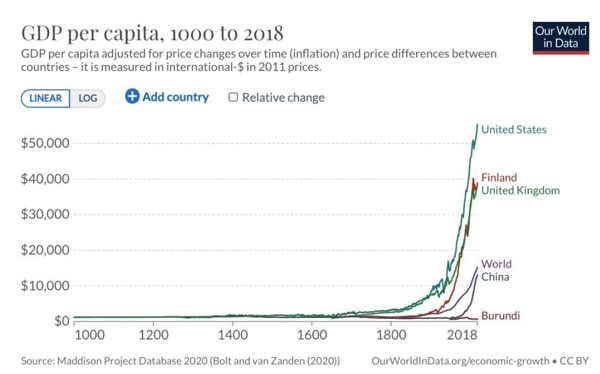
Image: GDP per capita 1000 - 2018 (Maddison Project) - Our World in Data
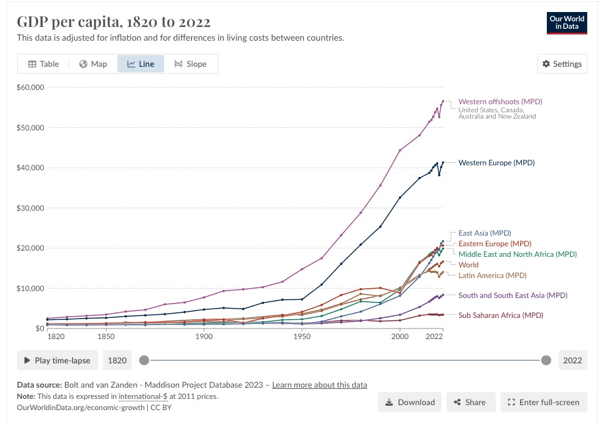
Image: GDP per capita 1820-2022 (Maddison Project) - Our World in Data
Tariffs & “Protection”
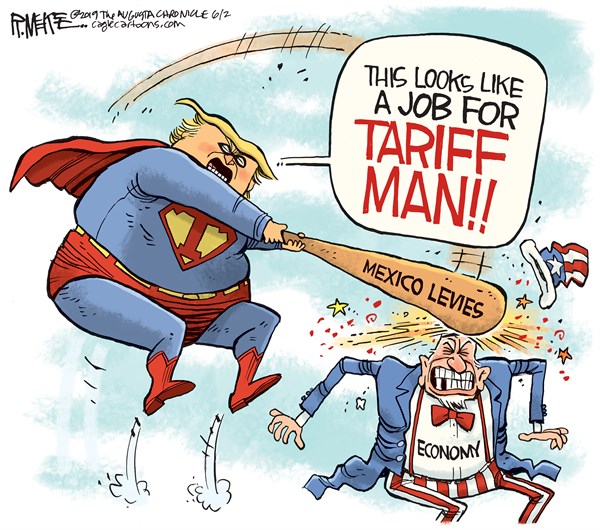
Image: cartoon of "Tariff Man" bashing Mexico
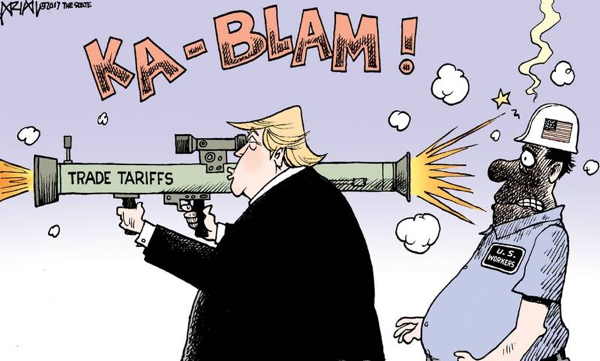
Image: cartoon of Trump firing "Tariff bazooka" and harming American worker standing behind him
The Protectionist Perspective
DT likes to call himself "Tariff Man" and seems to think that they are the key to solving America's problems and making it "Great" again
- DT wants to introduce an across the board 10% tariff on all imports
- punitive 25% rate on goods from Canada and Mexico (the US's 2 biggest trading partners)
- 60% rate on imports from China (its 3rd biggest trading partner)
- this will be collected by a new government Dept. the ERS (external revenue service)
- he believes this will be a “tax” paid by the exporting countries not by American consumers
- he believes this will revive American industry and improve the standard of living of American workers, and MAGA
To put this into historical context we need to note that:
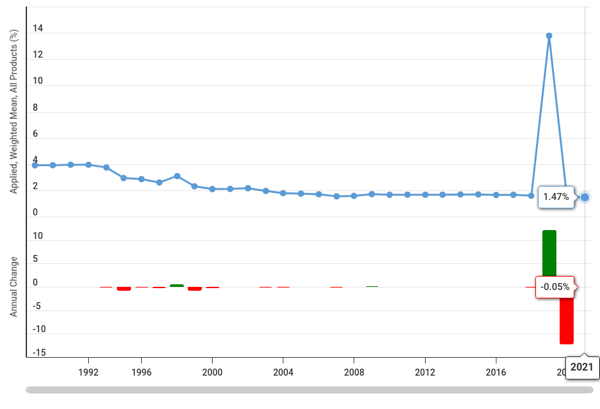
Image: U.S. Tariff Rates 1989-2021
- note Trump spike in his first term
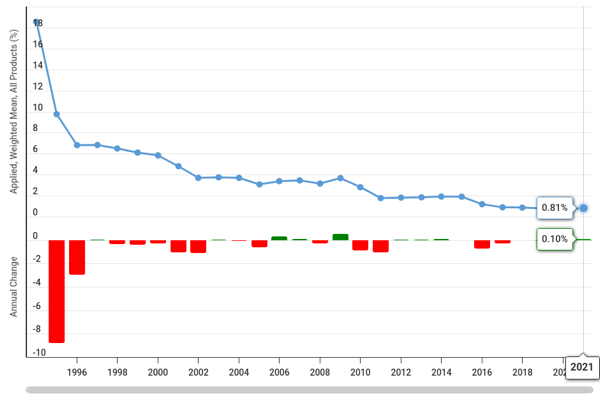
Image: Australian Tariff Rates 1991-2021
- the av. tariff rate in US in 2022 was only 2.8% (slightly higher than other members of OECD)
- the average. tariff rate in Australia in 2021 was 0.81%
600.jpg)
Image: Tariff Rates France, UK, USA (1830-2000)
US has historically been a high tariff country due to the influence of theorists like Alexander Hamilton and Friedrich List
- the "American System" , the Whig Party, Abraham Lincoln
UK led the way with free trade after repeal of the Corn-Laws in 1846 which lasted up until WW1
600.jpg)
Image: US Average Tariff Rates 1821-2018
- post-war decline in tariff rates
- huge increase with Smoot-Hawley Tariff (1930)
- steady decline world-wide after GATT 1947

Image: Av. Tariff rates Vic. and NSW (1825-1900) - Lloyd Australian colonial tariff rates:
- high in the first 50 years of 19thC
- by the end of the 19thC Victoria was a a high tariff state 12-15%
- NSW was a low tariiff state 6%
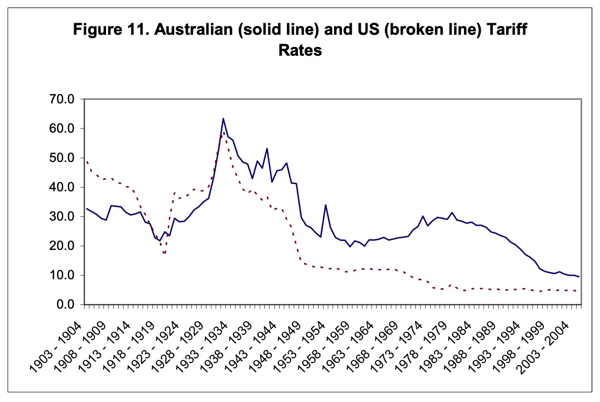
Image: Australia and US Tariff rates (1903-2004) (Lloyd 2007)
- Aust. rates dropped after WW2 but lagged the US
- remained high (above 20-30%) until the 1980s - due to protectionist Liberal-Country Party coalition govt.
- the liberalization of trade in Australia began with the 25% cut in tariffs by (surprisingly) the Labor Party under Gough Whitlam in 1972, which continued with the further liberalisation during the (Labor) Hawke-Keating governments and then the Howard-Costello (Liberal) governments
Free Trade perspective
- voluntary trade / exchange (i.e. “free trade”) between two parties benefits both (otherwise they would not make the exchange)
- by choosing to trade with A and not B I may “harm” B (B loses sales to a competitor) but I have not violated their rights and owe them no compensation and should suffer no penalty
- free trade creates greater wealth because of greater productivity due to
- the division of labour & specialization
- comparative advantage (different climates, resources, skills)
- historically, there is a difference between “revenue raising” tariffs (5%) and “protective” tariffs
- before the introduction of income tax and VAT in the 20thC tariffs were the main way govts. raised revenue
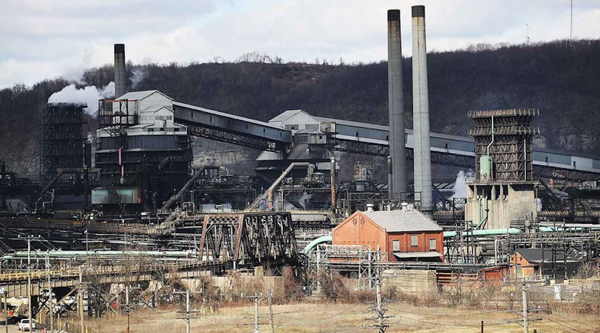
Image: Nippon Steel Co. and U.S. Steel Co.
This is a classic example of Bastiat’s “the seen” and “the unseen”
- what is “seen”: a factory is kept open, profits for the owners are made, wages of workers are paid
- what is “not seen”:
- customers pay higher prices for a good (if they in fact buy it at the higher price);
- this means they have less money to spend on other goods and services,
- the businesses whose products are not bought (and thus "not seen") have lower profits, might have to close, pay their workers less, or lay them off
- govt. interference in prices (tariffs & subsidies) creates distortions throughout the economy and bad incentives (rent-seeking)
A few more thoughts and comments:
- economists have been arguing about the costs and benefits of “protection” vs. free trade since 1776
- for even longer, domestic manufacturers have lobbied the govt. for "protection" from foreign competition
- a better term for this its a legal "privilege" granted by the govt. and enforced by its power of coercion, which benefits one group of owners, investors, managers, workers so they can have guaranteed sales in the home market and thus make profits, at the expense of everybody else
- periodic “tariff wars” have tightened international tensions
- late 19thC up to WW1 (Méline tariff)
- Smoot-Hawley tariff 1930 made depression worse
- trade barriers increase pressure for nations be be “autarchic” (Hitler’s Germany in the 1930s)
5. CONCLUSION
What does Trump “see” and what does he “not see”?

Image: DT with safety helmet and seeing the economy with only one eye
(See image above)
Image: Nippon Steel Co. and U.S. Steel Co.
- Trump has blocked the sale to a Japanese co.
“the Seen” - what DT thinks he sees
- decline in well-paying manufacturing jobs
- the US no longer “makes things” like it once did
- tariffs/taxes on imports will reverse this trend
- tariffs and industrial policy will MAGA
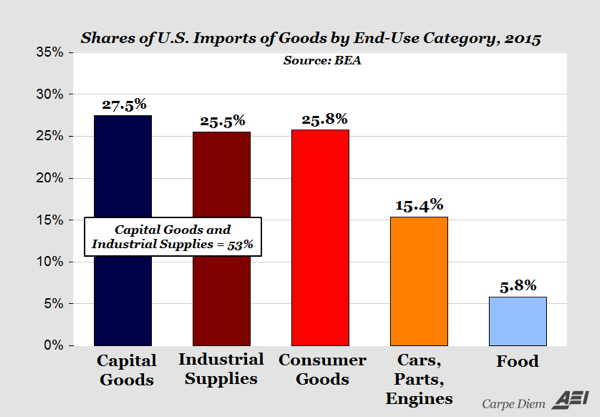
Image: % Imports which are intermediate inputs (Mark Perry AEI)
“the Unseen”
- decline in manufacturing employment began decades before China joined WTO
- US is still a very significant manufacturer but it requires far fewer workers to produce greater output (productivity)
- 53% of imports are "intermediate inputs" for US manufacturing (capital goods 27.5% and industrial supplies 25.5%) which are then sold within the US or exported, e.g. the intertwined car industry which has merged in Mexico, Canada, US after NAFTA; tariffs will increase these firms' cost and make them less competitive. Mark J. Perry, "Nearly All Imports, Even Consumer Goods, Are Inputs for US Firms, Retailers and Factories" AEI (Aug. 19, 2016) https://www.aei.org/carpe-diem/nearly-all-imports-even-consumer-goods-are-inputs-for-us-firms-and-factories/
- tariffs will only delay inevitable structural changes in manufacturing, similar to what happened in agriculture
- tariffs benefit some (politically swell-connected groups) but harm the majority who will have less to spend on other things
Other things to note - things which can be "foreseen" or predicted:
- DT is wrong to think that the new tariffs/taxes will be born by foreign countries and not by US consumes and producers
- DT is wrong to think that the countries on which he imposes the new tariffs will not retaliate with tariffs against American exporters; risk of a world-wide trade war like the one which prolonged the Great Depression
- it is a myth that U.S. prospered in 19thC because of tariffs , rather in spite of high tariffs (Doug Irwin); the US was a very large and rapidly growing free trade area (between the states); tariffs benefited privileged northern manufacturers but harms famers and southern economic interests
- DT ignores (or is unaware of)
- the benefits of the "creative destruction" (Schumpeter) of old, inefficient, and unprofitable firms which are kept in business by tariffs and subsidies
- the possibility of unexpected innovations appearing seemingly out of nowhere
- the danger of "regulatory or policy capture" by vested interest groups - the old "infant industry" argument for protection was still being put forward decades after (e.g. the Australian car industry)
- "central planning fallacy" - just as "central planning" of the entire economy failed under communism, attempts by western governments (like Trump MAGA and Albanese "Future Made in Australia") to centrally plan sectors of the economy will also fail for sound economic reasons :
Trump: Friend, Foe, or Schmo?
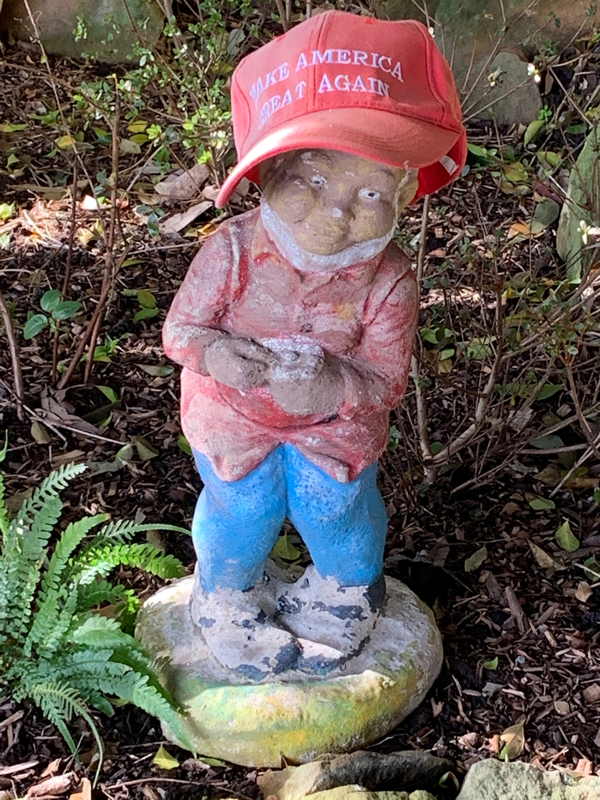
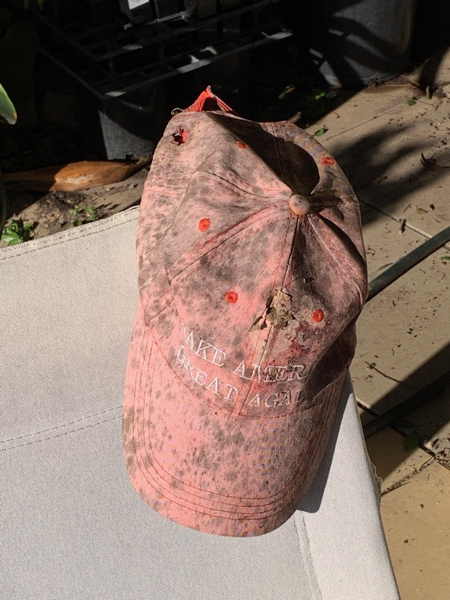
MAGA is a little the worse for wear.
Image: MAGA hat on my garden gnome
My conclusion:
- DT is a "foe" of economic freedom and prosperity for the ordinary consumer and worker
- DT is a "schmo" for his authoritarian bombastic behaviour and his ignorance of basic economics